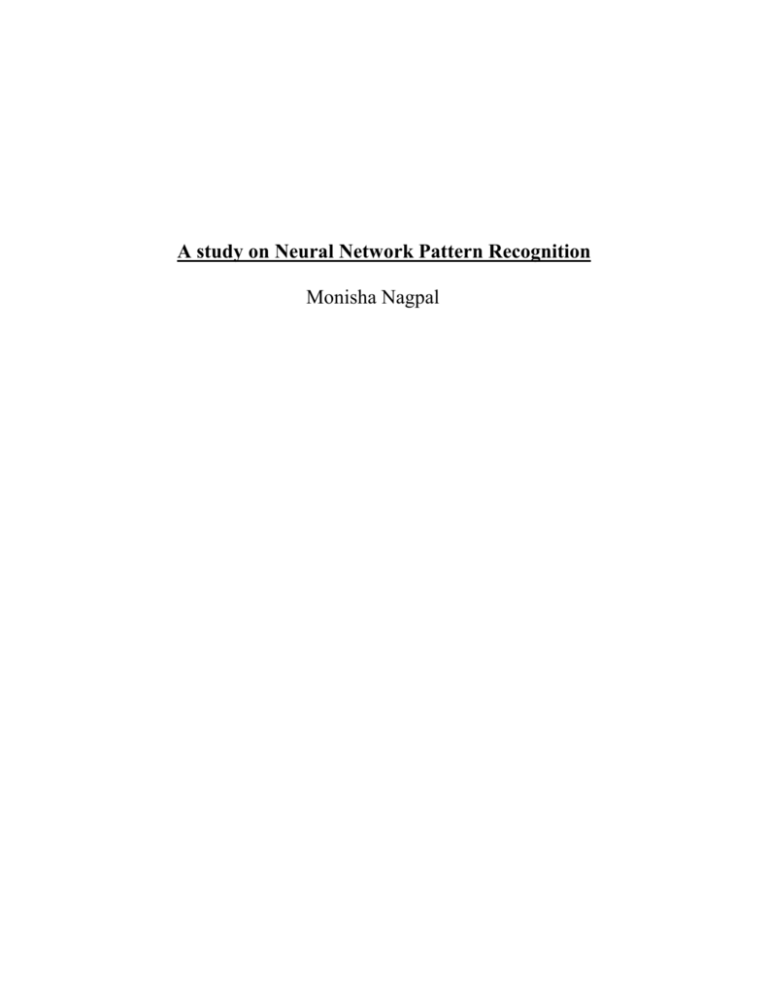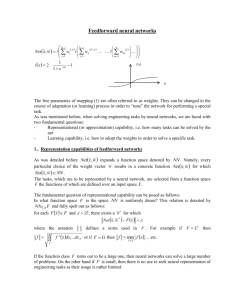Neural Network Pattern Recognition Implementing
advertisement

A study on Neural Network Pattern Recognition Monisha Nagpal A Study on Neural Network Pattern Recognition Abstract applications, such as data mining, web Among the various traditional approaches of searching, retrieval of multimedia data, face pattern recognition the statistical approach recognition, and cursive handwriting has been most intensively studied and used recognition, require robust and efficient in practice. More recently, the addition of pattern recognition techniques. The neural network techniques theory have been objective of this synopsis paper is to receiving significant attention. The design of summarize and compare some of the well- a recognition system requires careful known methods used in various stages of a attention to the following issues: definition pattern recognition system using NN and of pattern classes, sensing environment, identify research topics and applications pattern representation, feature extraction and which are at the forefront of this exciting selection, cluster analysis, classifier design and challenging field. and learning, selection of training and test Keywords: Pattern Recognition, correlation, samples, and performance evaluation. In Neural Network. spite of almost 50 years of research and INTRODUCTION development in this field, the general A pattern is an entity, vaguely defined, that problem of recognizing complex patterns could be given a name, e.g. with arbitrary orientation, location, and scale Fingerprint image, remains unsolved. New and emerging Handwritten word, Human face, Pattern recognition techniques are concerned Speech signal, with the theory and algorithms of putting IDNA sequence. abstract objects, e.g., measurements made on physical objects, into categories. Pattern recognition is the study of how Typically the categories are assumed to be machines can observe the environment, known in advance, although there are learn to distinguish patterns of interest, techniques to learn the categories Make sound and reasonable decisions about (clustering). Methods of pattern recognition the categories of the patterns. are useful in many applications such as The term neural network was traditionally information retrieval, data mining, document used to refer to a network or circuit of image analysis etc. neurons. The modern usage of the term often The term pattern recognition can be done by refers to artificial neural networks, which the using of Bayesian probability theorem. are composed of artificial neurons or nodes. The recognition of the pattern is summarized Thus the term has two distinct usages. To by the diagram shown below. provide an easier understanding of neural networks, we will begin by telling about the natural (biological) neural network (the brain), since the artificial neural network is actually a mathematic model of the brain. DATA ACQUISITION AND SENSING: Measurements of physical variables. Important issues: bandwidth, resolution, PATTERN RECOGNITION SYSTEM sensitivity, distortion, SNR, latency, etc. The pattern recognition in neural network Pre-processing: includes a Pattern Recognition System Removal of noise in data. which is used for extraction of the patterns, Isolation of patterns of interest from the can be explained by the following diagram background. and description. Feature extraction: Finding a new representation in terms of features. Model learning and estimation: Learning a mapping between features and Feature Selection: the next step in the design pattern groups and categories. cycle includes is the select features which Classification: extract features as Domain dependence and Using features and learned models to assign prior information, Computational cost and a pattern to a category. feasibility, Discriminative features(Similar Post-processing: values for similar patterns, Different values Evaluation of confidence in decisions. for different patterns),Invariant features with Exploitation of context to improve respect to translation, rotation and scale, performance. Robust features with respect to occlusion, distortion, deformation, and variations in DESIGN CYCLE environment. The design cycle of the pattern recognition Model selection: the next level is the is the flow diagram in which the data to be selection of model which includes the recognized is flowed and recognized. domain dependence and prior information, Definition of design criteria, Parametric vs. non-parametric models, Handling of missing features, Computational complexity, Types Data collection: it is the process of of models: templates, decision-theoretic or collecting training and testing data. It even statistical, syntactic or structural, neural, and helps us to know hybrid. the adequately large and representative set of samples including Training: The next phase is the training the data to be recognized. phase which includes the ways in which we learn the rule from data, even differentiate in is that the event will occur when a random supervised and unsupervised learning. The experiment is performed Supervised learning is one in which a teacher provides a category label or cost for each pattern in the training set. Whereas unsupervised learning is the system forms clusters or natural groupings of the input Conditional Probability patterns. Even the training includes the If A and B are two events, the probability of Reinforcement learning which is no desired event A when we already know that event B category is given but the teacher provides has occurred P[A|B] is defined by the feedback to the system such as the decision relation is right or wrong. Evaluation: the last phase is the evaluation phase which determines the performance with training samples and how the performance is predicted with future data. Even with this it includes the problems of over fitting and generalization. P[A|B] is read as the “conditional probability of A conditioned on B”, or simply the “probability of A given B” Bayes Theorem Bayes Theorem is definitely the Fundamental relationship in PROBABILITY Probabilities are numbers assigned to events that indicate “how likely” it Statistical Pattern Recognition which is obtained as Given B1, B2… BN, a partition of the P(x) a normalization constant that does not sample space S. Suppose that event A affect the decision occurs; what is the probability of event Bj Using the definition of conditional CONCLUSION probability and the Theorem of total Pattern recognition is a human activity that probability we obtain we try to imitate by mechanical means. There are no physical laws that assign observations to classes. It is the human consciousness that groups observations For pattern recognition, Bayes Theorem can together. Although their connections and be expressed a inter-relations are often hidden, by the attempt of imitating this process, some understanding might be gained. The human Where ωj is the ith class and x is the feature process of learning patterns from examples vector may follow along the lines of trial and error. Each term in the Bayes Theorem has a It has, however, to be strongly doubted special name as whether statistics play an important role in P (ωi) Prior probability (of class ωi) P (ωi|x) this process. Estimating probabilities, Posterior Probability (of class ωi given the especially in multi-variate situations is not observation x) very intuitive for majority of people. P (x|ωi) Likelihood (conditional prob. of x Moreover, the large amount of examples given class ωi) needed to build a reliable classifier by statistical means is much larger than it is REFRENCES: available for human learning. In human 1. GRAVA-a corpus based approach to the recognition, proximities based on relations interpretation of aerial images between objects seem to come before 2. A new concept for wireless features are searched and may be, thereby, reconfigurable receivers Palicot, J.; Roland, more fundamental. C.; Communications Magazine, IEEE For this reason and the above observation 3. Parallel Pattern Recognition Using a we think that the study of dissimilarities, Single-Cycle Learning Approach within distances and domain based classifiers are of Wireless Sensor Networks Amin, A.H.M.; great interest. This is further encouraged by Khan, Robertson, P.; Image Processing and the fact that such representations offer a Its Applications, 1999. A.I. bridge between the possibilities of learning 4. A handoff algorithm for wireless systems in vector spaces and the structural using pattern recognition Narasimhan, R.; description of objects that preserve relations Cox, D.C.; Personal, Indoor and Mobile between object’s inherent structures. We Radio Communications, 1998. think that the use of dissimilarities for 5. Earth Observation Remote Sensing and representation, generalization and evaluation GIS Services for Monitoring of Integration constitute the most intriguing issues in Systems Kurnaz, S.; Rustamov, R.B.; pattern recognition. Recent Advances in Space Technologies, 2007.







